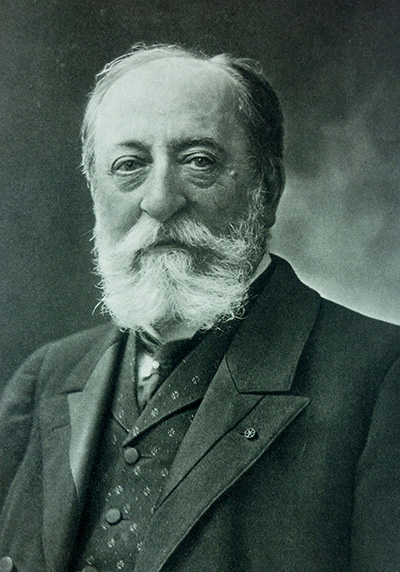Camille Saint-Saëns

- Born: October 9, 1835, Paris
- Died: December 16, 1921, Algiers
Introduction and Rondo Capriccioso, Op. 28
- Composed: 1863
- Premiere: April 1867 with violinist Pablo de Sarasate
- Duration: approx. 9 minutes
Saint-Saëns composed the Introduction and Rondo Capriccioso for Pablo de Sarasate. Sarasate, whose real name was Martín Melitón Sarasate y Navascues, was one of the great violin virtuosos of the 19th century. He was known for his technical brilliance, perfect intonation, pure tone and effortless playing. His friend Saint-Saëns was a virtuoso of another sort: he was a brilliant and effortless composer. He created a great many works, in virtually all genres, with apparent ease. It is not surprising that these two men were temperamentally well suited to one another, that they became good friends and that Saint-Saëns wrote a number of pieces for Sarasate.
Sarasate was a child prodigy. When he was five years old, he heard his father—a violinist and the bandmaster of the picturesque fortress town of Pamplona—struggling to master a difficult violin passage. The young boy played the passage flawlessly on his miniature fiddle. The father, humiliated yet proud, never again played the violin. But he recognized his son’s talent and sent him to study with some of the greatest violin pedagogues in Europe.
Sarasate was eight years old when he played a concert that won him a scholarship to study in Madrid. Four years later Queen Isabella sent him to the Paris Conservatoire to work with Delphin Alard. The boy was to be accompanied on this exciting journey by his mother. During the long train trip, however, his mother suffered a heart attack and died. The Spanish consul at Bayonne took the boy into his home, where Sarasate was discovered to be suffering from cholera. The consul personally nursed him back to health. When Sarasate finally arrived in Paris, his teacher Alard arranged for him to live with an administrator of the Conservatoire, who treated him like a son. In 1859, at the age of 15, he began to tour Europe.
Sarasate was constantly annoyed by the trivial music he was forced to play. There had been too few worthwhile pieces composed for violin since the classical era. He sought to solve this problem by asking several leading composers to write specifically for him. The first composer he approached was Saint-Saëns, who was then 24. Saint-Saëns later recalled his first meeting with the 15-year-old virtuoso:
Fresh and young as spring itself, the faint shadow of a moustache scarcely visible on his upper lip, he was already a famous virtuoso. As if it were the easiest thing in the world, he had come quite simply to ask me to write a concerto for him. Flattered and charmed to the highest degree, I promised I would, and I kept my word with the Concerto in A Major.
Saint-Saëns had previously written one not particularly successful violin concerto. But it was only once he began working with Sarasate that the composer learned the real art of solo violin composition. Most of his later works for violin were created for and with the help of the Spanish virtuoso.
Four years after he met Sarasate, Saint-Saëns wrote the Introduction and Rondo Capriccioso, conceived in a Spanish style specifically for his friend. This piece quickly became standard virtuosic fare, whether performed in the original version with orchestra or in an arrangement by Georges Bizet for violin and piano. Sarasate performed it widely, thus making Saint-Saëns’ name known in many countries. The composer acknowledged, “In circulating my compositions throughout the world on his magic bow, Pablo de Sarasate rendered me the highest of services.”
—Jonathan D. Kramer